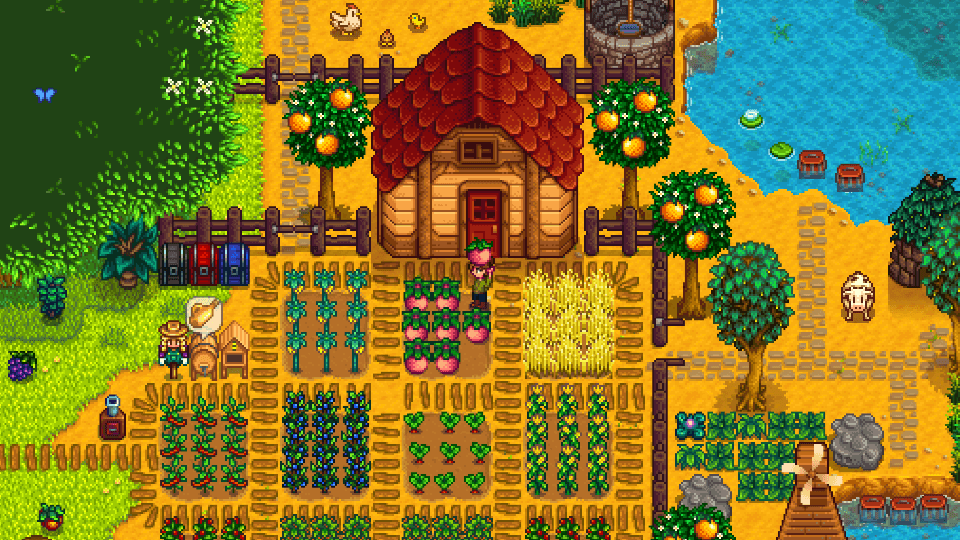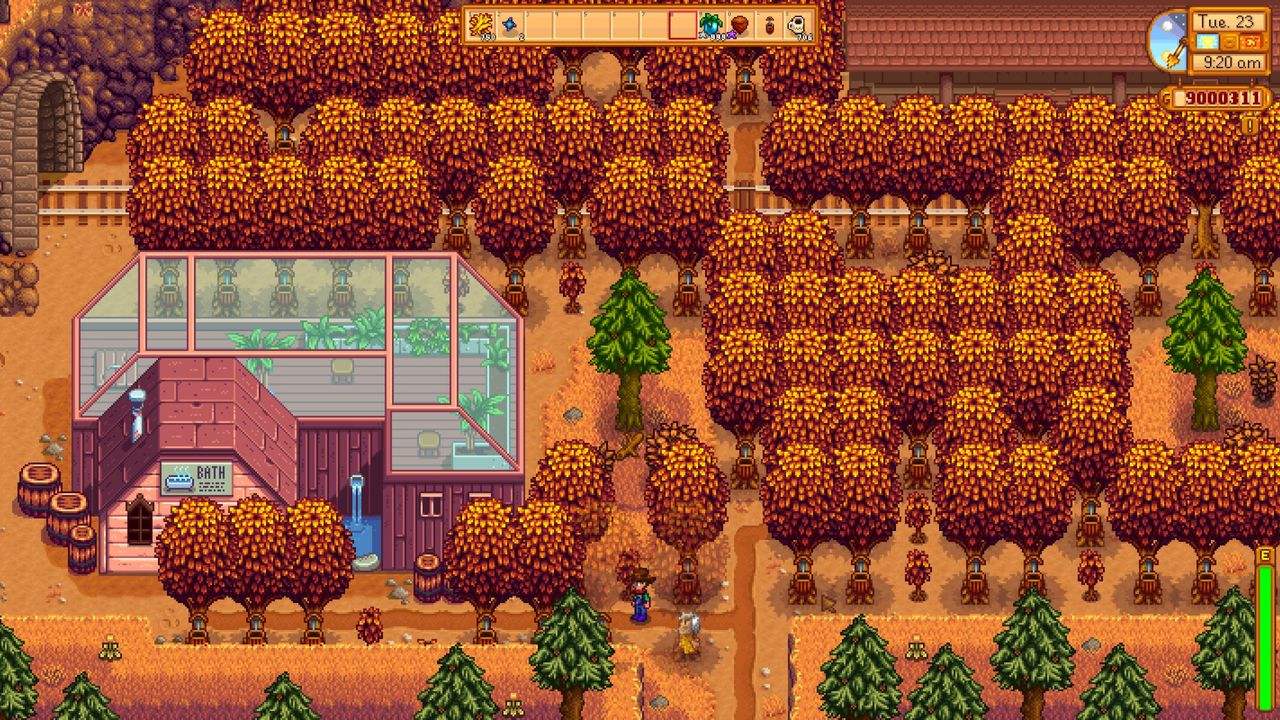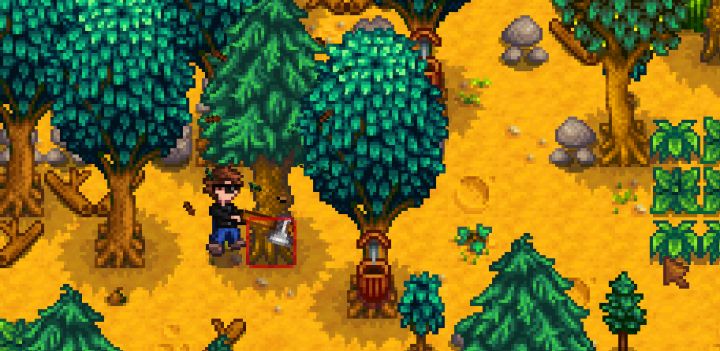Table of Contents Show
Stardew Valley: Foraging Guide
This guide will teach you the basics and more advanced features of foraging and will help you level up your foraging skill, one of the easiest and cheapest ways to make money in Stardew.
XP and Leveling
foraging is a slow skill to level but is cheap and easy skill, you can level up your foraging by chopping down fully grown trees (12xp given all at once after the tree falls) stumps (1xp) and both Normal and Hardwood Logs (25xp) and by picking up Forage Items from around Stardew Valley (all foraging items give 7xp with the exception of Snow Yam and Winter Root which give nothing and Spring Onions which give 3xp) Truffles (7xp spawned by Pigs from the Barn when let out) growing Wild Seeds (3xp when harvested)
it is worth noting that XP is gained from the action and not from selling the items, also of note is that Berries like Salmonberries and Blackberries give no XP when harvested from bushes and only give XP when picked from the ground, when picked from the bush they give no XP, Mushrooms obtained from Mushroom Trees and the Farm cave also give no XP and Foraged items gained from killing Monsters also give no XP.
Foraging Skill Tree
Level 1:
Wild Seeds (spring)
Field Snack
– Trees sometimes drops seeds
with level one there isn’t much, if you are dedicating to foraging and not doing it as a side thing the wild seeds are useful as you can use them on the farm as a way to fill in the gaps of low forage days and the field snack isn’t great as you can utilize the seeds much better as you progress in the skill tree (mainly level 3) speaking of which as you are clearing the farm make sure to keep all your tress seeds safe especially maple trees as we are going to want to save these for a tapper farm later.
Level 2:
Survival Burger
a fairly lacklustre level up but the Survival Burger is a very useful tool for the Berry Seasons as consuming one gives you a buff of +3 to your foraging skill for 5 minutes and 35 seconds, meaning that consuming one of these will temporarily grant you an extra berry when harvesting from bushes and who doesn’t like free money? so if you can make one for the berry seasons definitely do it but don’t go out of your way to do so as foraging at low levels doesn’t net a massive amount of money.
Level 3:
Tapper
now we can get started, craft as many of these as you can as soon as you can, make yourself a maple syrup farm and start making some neat reliable money Maple Syrup is the best out of the Tapper Produce as it sells for the most and has the most gift potential and I used in 2 community centre bundles (you do want the good ending right?) 7-8 days to produce and 200 gold flat (well 250 if you take tapper skill) why not, also you can put tappers outside of the farm too to really expand your profits.
Level 4:
Charcoal Kiln
Wild Seeds (Summer)
– +1 Wild Berry Harvest
Charcoal Kiln is nice, means less trips into the mine and Wild Seeds again, the big kicker is the Wild Berry Harvest granted by the time you get this Salmonberry season will have ended (15th to 18th) and our next berry season is Blackberries in Fall (8th to 11th) but it’s still useful to have.
Level 5:
The first big choice Forester or Gatherer, depending on the path you are going there are a few things to consider
Forester:
if you are taking this path you are aiming to cover all of Stardew in Tappers and maximize Syrup Profit, the actual perk of this isn’t very useful wood only sells for 1 gold more and it’s better used on hardwood so if you want to make money from this you’ll want to open the secret forest and start farming hardwood, in reality you are taking this to get Tapper at level 10.
Gatherer:
The better choice, Foraging is free and doesn’t cost you any resources and now you have a 20% chance at getting 2 for the price of 1, Gatherer is great and an easy tree that is well worth taking
Level 6:
Lightning Rod
Wild Seeds (Fall)
Warp Totem Beach
not bad, we get our first warp totem which just so happens to be a warp to a good foraging spot (well that is if you have built the bridge but by now you should have) and Lightning Rod which is nice for not having your stuff destroyed by a violent and sudden electrostatic discharge of 1 billion volts.
Level 7:
Wild Seeds (Winter)
Warp Totem Mountains
relatively lacklustre until you realize that Wild Seeds (Winter) are the only seeds that can grow outside during winter, so you can keep a farm going and have emergency Foraging for low luck days.
Level 8:
Warp Totem Farm
– +1 Wild Berry Harvest
Yay more Berries! Also, the Warp Totem is nice if you are playing Multiplayer and have a friend specializing in Mining who is always late home because “just one more level” and before they know it it’s 1:30am.
Level 9:
Rain Totem
Don’t want to have to water your seeds or have a farming specialising friend in multiplayer? then these are great, save energy for other things.
Level 10:
the Big Decision
Forester
Lumberjack:
It’s nice but like I said Lumberjack isn’t one of the best ways to make money with trees
Tapper:
now THIS is how you make money with trees, granted it’s not a massive increase but a little extra profit doesn’t hurt, every penny helps!
Botanist:
always Iridium Quality foraged items, uh yes please, what an amazing skill just the best, especially if you are also following the artisan tree (which you really should) high quality Wines and Jellies, what’s not to love.
The Botanist Skill applies Iridium Quality to:
- All items labeled as “Forage” in-game (except Sap and Cave Carrot)
- Fruits, vegetables, and flowers found as forage (including Salmonberries and Blackberries shaken from bushes during their respective seasons)
- Fruit left by fruit bats in the cave, provided the player chose that option when prompted by Demetrius (mushrooms are not affected)
- All items foraged from the beach
- Crops grown from Wild Seeds
- Truffles
Tracker:
just no, if you need this you haven’t been paying attention, a terrible skill really, not much else to say.
Tips and Trail
The Trail
foraging can take a while sometimes so I’ve developed a great path that lets you hit all the spots quickly (I’m going to make a video for it but for now follow these steps)
- head north of the farm house
- pick up anything on the path towards the mines
- head all the way to the adventures guild and then back
- head south into town
- walk past the community centre and to the play ground
- head back to the farm
- if you saw anything from the bridge check left of the bus
- if not continue to the farm and head south to the forest
- go to the sewers
- head west towards Poke
- north towards the Wizard Tower
- head east towards town
- pass the graveyard and then head to the beach
- loot the beach and if you have the bridge repaired loot that too
- head out of the beach and towards the Museum and Blacksmith
- Trail Finished
Tips:
A few things of note, 0-4 new forageables spawn each day in every area of the map with a hard cap of 6 spawns in any given area and all foragables reset when the player sleeps on Saturday Night with the only exceptions being the area to the right of the beach acsessable once you use 300 wood to repair the bridge and the Spring onions that grow south of Leah’s Cottage, the items in these areas don’t count towards the cap and reset every day
The Berry Seasons on Spring 15th to 18th and Fall 8th to 11th berries will spawn on the bushes around town, whilst these don’t give XP they do give some good money and can be used to create wine and jelly if you stockpile them which is great for doing artisan alongside your foraging
On the 7th, 14th, 21st and 28th of each month there’s a surge of foragables, make sure not to skip the foraging on these days or you’re missing out on a huge haul.
Make sure to keep aside one of each foragable needed for the Crafts Room Community Bundles.
Spring:
Wild Horseraddish, Leek, Dandelion, Daffodil
Summer:
Grape, Spice Berry, Sweet Pea
Fall:
Common Mushroom, Wild Plum, Hazelnut, Blackberry
Winter:
Winter Root, Crystal Fruit, Snow Yam, Crocus
Demetrius and the Cave
I made this its own catagorie because I think this is an important choice and until doing more resarch I didn’t realise how much this choice can affect your play.
So after you accumulate 25,000g in total earnings Demetrius will visit the farm and give you two options of the cave, Fruit Bats or Mushrooms.
Fruit Bats
Fruit Bats drop fruit in the cave for you, how nice of them, they drop at a rate of on average 0.8 per day, the good thing about this is that the bats will give you fruit even out of season making the Artisan Bundle easier to complete if you haven’t set up fruit farms, its also great for Artisans who are making Wine and Jelly and fruit is a universal like making it a great gift for the villagers, as a plus in the late game the Botanists Skill from Level 10 Foraging will make these fruits Iridium Quality which is even better for Artisans.
Mushrooms
I always used to pick this but after doing my research I’ve actually found that this isn’t as great a choice as I thought it was, the Mushrooms made from the gave give no XP and will not be affected by the Botanist Skill or the Gatherer Skill, the one plus is that the mushrooms can be used for Life Elixir so its good for mine expeditions, this choice is good if you intend to have a large fruit tree farm.
Farm Based Foraging
Tappers and Tapping
there are 3 types of tree in the game and the best type for tapping is Maple, the others have their uses too but you are going to want to dedicate most of your resources to Maple.
Reason being that Maple sells at the highest price, makes a great gift for villagers and in the last 2 weeks of Fall Maple trees have a chance to drop Hazelnuts. For setting up a Tapper farm its quite simple and doesn’t use up much space.
Normal trees can grow with a space of only one square between them compared to fruit trees that need a 3×3 area in order to grow.
To set up a tapper simply walk up to your desired tree and place the tapper on it, after that depending on the tree it will take 4-8 days to produce some Syrup, Resin or Tar, from then on they will continue to produce those items even during winter.
The tappers can also be placed on Mushroom trees that have a rare chance of spawning during Fall the produce the tapper makes on this tree works in a weird way but considering it doesn’t award anything for foraging other than the produce I’m not going to go in depth.
To remove a tapper simply take out your trusty axe and smack the tree that has the tapper you want back, it will plop of the tree and go into your inventory ready to be placed again.
Wild Seeds
Wild seeds are very useful as they give foragers a consistent way to gather foragables even on days with low luck where you have a low spawn rate of foragables outside the farm and can be grown during winter.
Wild Seeds take 7 days to grow and Crows do not attack them so Scarecrows are not needed to protect them (giving us even more space for crops) however it is worth noting that if you are aiming for maximum profitability the recipe used to create Wild Seeds is cheap and selling the seeds yields more profit over selling the regular and gold quality ingredients used to craft it with the Botanist skill however this changes as the 10 seeds sell for 350 gold but the ingredients at Iridium sells for 360 gold.



